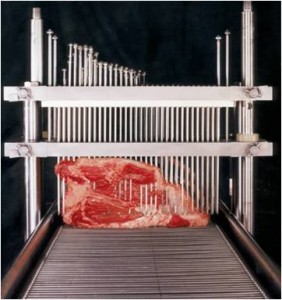In mid-1994, Michael Taylor was appointed chief of USDA?s Food Safety and Inspection Service.? On Sept. 29, 1994, USDA said it would now regard E. coli O157:H7 in raw ground beef as an ?adulterant,? a substance that should not be present in the product. By mid-October, 1994, Taylor announced plans to launch a nationwide sampling of ground beef to assess how much E. coli O157:H7 was in the marketplace. The 5,000 samples would be  taken during the year from supermarkets and meat processing plants ?to set an example and stimulate companies to put in preventive measures.? Positive samples would prompt product recalls of the entire affected lot, effectively removing it from any possibility of sale.
taken during the year from supermarkets and meat processing plants ?to set an example and stimulate companies to put in preventive measures.? Positive samples would prompt product recalls of the entire affected lot, effectively removing it from any possibility of sale.
That?s the long-winded version for what a USDA official said in a 1994 television interview: we?ll stop blaming consumers?when they get sick from the food and water they consume.
With 15 confirmed E. coli O157 illness across Canada linked to XL Foods in Alberta, the company laid off 2,000 employees Saturday, then called 800 back to work so they can get on with re-opening the plant the Canadian Food Inspection Agency closed Sept. 27, 2012.
Gerry Ritz, Minister of Agriculture said, ?My thoughts are with the workers and the community affected by this private sector business decision.?
He didn?t say anything about the sick people, other than platitudes about how ?we won?t compromise when it comes to the safety of Canadians? food.?
But there?s lots of others eager to blame consumers, almost 20 years after the Jack-in-the-Box outbreak sparked Taylor?s actions.
Dr. Jean Kamanzi, who used to be a director at the Canadian Food Inspection Agency and now is responsible for food hygiene in Africa for the United Nations Food and Agriculture Program said any E. coli bacteria in the meat could be rendered harmless if it?s cooked to a safe internal temperature ? 71 degrees Celsius.
?The meat we?re now throwing into the garbage, which contains this so-called E. coli, if you take it and cook it like you?re supposed to there?s no problem. It?s edible. These are good proteins. ? ?This is collective hysteria. We?re throwing away meat, we?re throwing everything away. Maybe we?re in a rich country and we can allow ourselves the luxury of not taking any risks at all ? but these risks, we take them every day when we touch meat.?
Jean?s point about this being a problem for wealthy countries is taken, but it?s not collective hysteria, especially to the people who got sick.
Dr. Sylvain Quessy, who teaches meat hygiene and is the vice-dean at the faculty of veterinary medicine at the University of Montreal, says that, from a statistical standpoint,  the number of illnesses associated with the type of E. coli in the XL Foods safety investigation ? 15 Canadian cases in a month ? is not especially alarming.
the number of illnesses associated with the type of E. coli in the XL Foods safety investigation ? 15 Canadian cases in a month ? is not especially alarming.
?Everyone?s worrying about a number of cases that is not excessive compared with what you?d normally expect. What we?re telling people ? it?s as true now as it was before ? is you need to cook your meat properly. (And) wash your hands and wash the things the raw meat touched and you eliminate the danger.?
Sylvain Charlebois of the University of Guelph, said, ?If you cook your meat correctly and thoroughly, you will likely eliminate all risks. I would argue that if we educate the public, and we make sure that consumers know what to do with their beef products, you will likely eliminate most of the risks.?
And I thought Australia was stuck in the 1980s.
The feds responded, ?despite the fact that proper cooking and handling of food helps prevent illness, the best way to protect yourself is to not eat recalled products at all.?
Taylor did what he did back in 1994 based on the extreme virulence of shiga-toxin producing E. coli like O157:H7, the underestimated risk of cross-contamination, and that food safety isn?t simple, it?s complex. Consumers and food service workers have a role, but these other factors mean loads must be reduced throughout the system.
And this is without getting into the risk of needle- or blade-tenderized steaks and roasts, which sickened some of the people in the XL outbreak.
Just cook it doesn?t cut it. The U.S. meat industry has been told this for years. Why doesn?t  Canada?
Canada?
And although officials insist it was planned months before the XL fiasco, CFIA is going to be audited later this month by the U.S. Department of Agriculture for the first time in three years.
Canada exported more than $4 billion worth of beef and pork in 2010, much of it to the United States.
The final USDA report from its 2009 CFIA audit found weaknesses in the ability of Canadian inspectors to verify consistent sanitation and hazard protection in some slaughter plants, but noted the agency was planning to take action to deal with the shortcomings.
It also said agency inspectors and supervisors were routinely not following procedures for monitoring sanitation controls as laid out by the CFIA.
?Principal areas of weakness included the inability of inspection personnel to implement consistent sanitation and hazard analysis and critical control points verification procedures,? says the report, which was sent to the CFIA in October 2010.
?And, more significantly, (there is) the lack/loss of consistent supervisory reviews to identify weaknesses in inspection performance when it occurred.?
The report did find that the Canadian inspection system adequately verified testing for generic E. coli.
This banter is of no use to people sickened in the outbreak.
Source: http://barfblog.com/15-sick-food-safety-failures-arrogance-in-canadas-e-coli-o157-outbreak/
snow day snow day neti pot iron chef bath and body works coupons jeff probst jeff probst
No comments:
Post a Comment
Note: Only a member of this blog may post a comment.